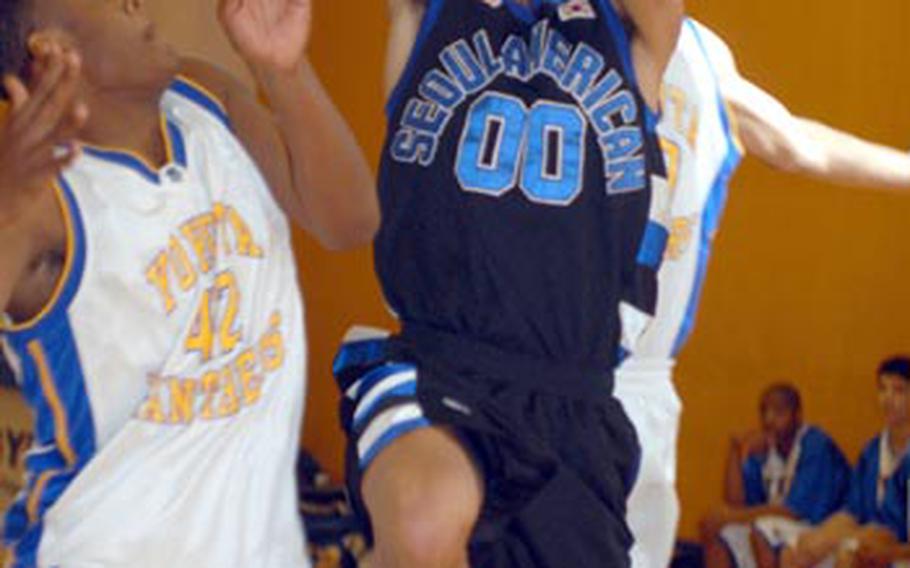
Seoul American’s Marcus Thompson looks to shoot past Yokota’s Keron Brown, left, and Antony Phillips on Dec. 20 during the 3rd New Year Classic high school basketball tournament. Yokota coach Paul Ettl and Seoul American coach Steve Boyd are preparing for Far East tournaments without a shot clock, but would like to have it back. (Dave Ornauer/S&S)
YOKOSUKA NAVAL BASE, Japan — They’re playing without a shot clock. But that doesn’t mean they’re liking it.
With shot clocks eliminated from this season’s Far East high school basketball tournaments, teams and leagues have almost universally done away with them for regular-season play as well, with the Kanto Plain Association of Secondary Schools being the lone holdout.
Halfway through the season, unhappy coaches are suggesting they want the clock back, even if they have yet to be affected by playing without it.
"It makes for a lot better basketball," Seoul American boys coach Steve Boyd said in favor of timed possessions during last month’s New Year Classic.
Many coaches at the tournament agreed.
"I like the game with the clock. It makes for a more exciting game," said Yokota coach Paul Ettl, whose Panthers won the classic. "Taking away the shot clock is a major change."
Not everyone shares his view.
"I’m happy without it [the clock]," said longtime Osan girls coach Bruce Barker. "It’s a game of strategy and patience as opposed to running up and down the court."
And Far East Activities Council chair Don Hobbs said simply, "The defense is going to have to force the offense to force the action."
Shot clocks — 35 seconds for boys and 30 for girls — have been used in Far East Class AA tournaments since 1995 and in Class A tournaments since 2004.
But in March, FEAC voted to eliminate the shot clock, Hobbs said, to bring DODDS-Pacific basketball more in line with what’s done in the States and DODDS-Europe.
Only five states use a shot clock, and DODDS-Europe doesn’t use it.
"It was felt that we [Pacific and Europe] should have the same rules," Hobbs said in an e-mail.
Another reason for doing away with the clock is cost savings, Hobbs said. While shot-clock operators earn only $10 per game, "it adds up" over the course of a season and especially in Far East tournaments, which feature as many as 50 games.
As a result, DODDS-Japan, the Okinawa Activities Council, and the Korean-American Interscholastic Activities Conference voted to eliminate the shot clock for regular-season play. Only the Kanto Plain has retained the shot clock.
"That’s their decision," Hobbs said of the Kanto Plain. "But they have to understand that the shot clock will not be used at Far East. … They are encouraged not to use it so they can become familiar with not having it."
So what’s the big fuss with coaches?
They might be forced to spread their defense to cover more ground for much longer than they did with a shot clock.
"That’s hard to do," coach Fred Sava of St. Mary’s International said. "With the clock, you defend to the three-point line; eventually, somebody has to step up and shoot."
"You can do things defensively in 35 seconds that you can’t do in three minutes," Ettl said.
What coaches are especially fearful of are teams that favor slowdown, even stall tactics.
"That’s not basketball to me," Boyd said.
Osan’s girls held the ball in the second half of its 40-21 victory over Matthew C. Perry in the 2002 Class A title game. In that game, Perry’s defenders, unwilling to come out of a 2-3 zone and guard far away from the basket, broke into a dance in the third quarter when Osan held the ball at midcourt.
Hobbs was involved in a similar game in 1992 as coach of the Kubasaki boys team, when his Dragons mustered a fourth-quarter rally to beat Kadena 19-10.
"Defenses are going to have to make adjustments. They’re not going to be able to sag five to 10 feet away and play loose-fit defense," Hobbs said.
Coaches such as Boyd counter that the singular solution to stall tactics is to return to the familiar.
"The only thing that can stop [stalling] is a shot clock," Boyd said. "I always vote for it [clock]. My team is geared toward it."
But not every team possesses the talent to run with the big dogs, especially at the critical point guard position, Barker said. Most smaller schools in South Korea tend to lose players to transfer as quickly as they develop them.
"The pool is small. You’re only going to get one or two [really good players]. With DODDS, the rotation is constant."
That lack of a big player pool means most small schools aren’t geared toward the up-tempo style, he said. "This isn’t the pros or college. It’s a high school game. It deserves to remain a high school game," Barker said.